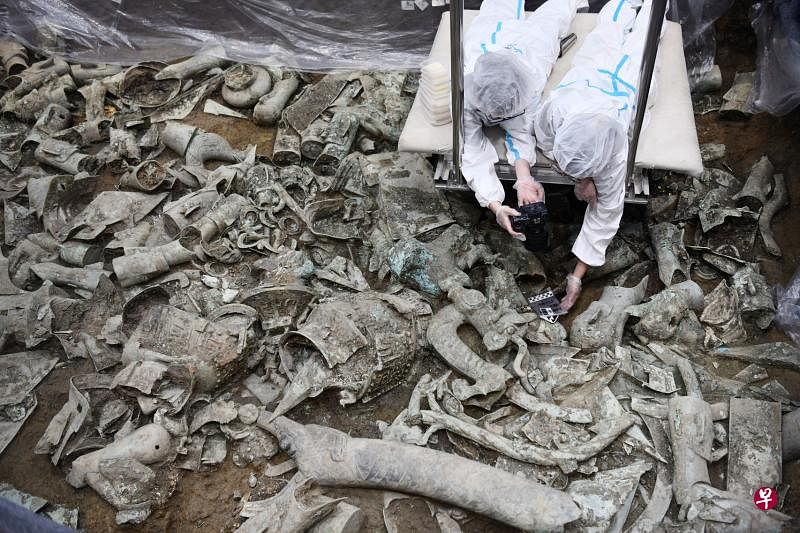
The Sanxingdui cultural relics protection and repair hall with an area of about 1,000 square meters opened in December last year.Tourists can not only see the newly unearthed cultural relics here, but also watch the cultural relic workers "beauty" at close range.Guo Hanzhong introduced that the work and visiting area in the museum is separated by transparent glass doors and windows. Tourists' voices will not interfere with the cleanup and repair of cultural relics. At the same time, it will allow tourists to better understand the entire process of cultural relics.
China's first cultural relics protection and restoration museum to the public, at the end of last year at the Sanxingdui Museum in Sichuan.Lianhe Zaobao reporters visited Sanxingdui again last week and found that a large number of cultural relics lying in the archeological scene of sacrifice pits last May not only were unearthed, but also partially placed in the new museum for visitors to appreciate, including so far in Sanxingdui discovery body.The largest bronze mask.
The Sanxingdui site is located in Guanghan City, north of Chengdu, with an area of 12 square kilometers. It was first discovered in the late 1920s and was known as one of the greatest archeological discoveries of human beings in the 20th century.Following the excavation of the No. 1 and No. 2 sacrifice pit in 1986, the Chinese archeological team was found to be newly discovered around the original two sacrifice pits at the end of 2019.Essence
At present, the largest bronze mask is 131 cm wide and weighs 66 kg.Guo Hanzhong, deputy director of the Cultural Insurance Center of Sanxingdui Museum, introduced in an interview with Lianhe Morning Post that the cultural relics extracted from the six sacrifice pits are currently in the clean -up stage, including only physical support and reinforcement, including the bronze mask, etc.The original appearance in the pit.
Guo Hanzhong, who began to participate in the archeological restoration of Sanxingdui as early as 1984, revealed that the restoration of the unearthed cultural relics must be launched by the expert team and the National Cultural Relics Bureau.
The Sanxingdui cultural relics protection and restoration museum with an area of about 1,000 square meters (equivalent to about two and a half basketball courts) opened the museum in December last year.Tourists can not only see the newly unearthed cultural relics here, but also watch the cultural relic workers "beauty" at close range.
Guo Hanzhong introduced that the work and visits in the museum are partitioned with transparent glass doors and windows. Tourists' voices will not interfere with the cleanup and repair of cultural relics. At the same time, it can also allow tourists to better understand the entire process of cultural relics."((This new approach) is more attractive, not like it is very closed, and let everyone see it." At the same time, in order to satisfy the expectations of tourists to see the newly unearthed cultural relics as soon as possible, the restoration hall also chooses some representative cultural relicsAccelerate the display.
The new museum currently shows the unprecedented gold mask discovered from the pits 5, the scale and volume; from the No. 4 pit, the strange bronze of the posture turned to kneel and sit on the portrait.
Zhu Yarong, deputy curator of the Samsung Dou Museum, said in an interview that the restoration hall was very popular since the opening of the museum. The number of tourists with tens of thousands of tourists a day before the recent epidemic in Chengdu, and more than 3,000 people still received the epidemic day.
She said that under the leadership of the Cultural Relics Bureau of Sichuan Province, a joint working mechanism was set up between the museum and the archeological team to break the previous independent operations through this innovation.Then the display can be seamlessly connected, so that the museum can show new unearthed cultural relics faster.
It is understood that the archaeological excavation work of the six sacrifice pits has now entered the ending stage, and nearly 13,000 cultural relics unearthed.Except for the pits 5 and No. 6 pit, the other four sacrifice pit were buried in the same age, which was at the late period of the Shang Dynasty and at least 3,000 years ago.
Archaeological experts who have worked at the Sanxingdui site for more than 30 years revealed that the cultural relics extracted from eight sacrifice pits are still incomplete; the unearthed utensils of Sanxingdui are generally in three groups, but some combinations are only found among them among them.One or two, "There are many phenomena."
He previewed that after the collection of the sacrifice pit cultural relics, the archeological team may investigate the area north of the Sanxingdui site, "there should be wonderful cultural relics."
A new round of archeological achievements in Sanxingdui will accelerate the pace of application
Thunderstorm is a researcher at the Sichuan Provincial Institute of Cultural Relics and Archeology and the head of the Sanxingdui workstation.He said that Sanxingdui has not found the trace of text. The experts are currently hoping that the turtle back -shaped mesh -shaped grids found in the Pit 7 pits. "If there is still no (text),It's really hard to find. "
On the other hand, Zhu Yarong introduced that Sanxingdui and the Jinsha site in Chengdu have jointly applied for World Cultural Heritage. It is currently included in the preparatory list of Chinese application. It is believed that the new round of archeological achievements in Sanxingdui will accelerate the pace of application.
But she frankly said that Sanxingdui and Sands, as soil sites without external buildings, are more disadvantaged in application. They must continue to deepen the depth of archeological excavation research to increase the weight of successful application.
Sanxingdui Museum also started construction of new museums in March this year, with a total investment of more than 1.4 billion yuan (S $ 288 million) and an area of 55,000 square meters.The bottom is open.




